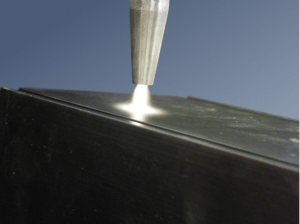Andrew Sasser ’23, Applied Sciences, Fall 2020
An example of a cold atmospheric pressure plasma nozzle emitting plasma (ionized gas). Cold atmospheric plasma – plasma produced near room temperature – has been found to be potentially effective in deactivating the SARS-CoV-2 virus (Source: Wikimedia Commons)
When it comes to COVID-19, one of the modes of transmission between people is via contact with surfaces containing coronavirus viroids. In recent studies, coronavirus virions have been found to have a half-life – the time needed for half of the virions to dissipate – of between 1.7 and 2.7 days on non-porous surfaces ranging from paper money to stainless steel and glass (Riddell et. al, 2020). With this rate of decay, viable virus was detected on these surfaces up to 28 days after initial contact by droplets. Although elevated temperatures of 40˚C and above have been found to deactivate the virus in less than 24 hours, this heat-inactivation method is likely too energy intensive to be applied at large scales (Riddell et. al, 2020). Additionally, some disinfectants used for cleaning COVID-19 contaminated surfaces can present potential safety concerns due to their capacity for skin irritation, thereby limiting their efficacy (Chen et. al, 2020).
However, recent studies by Chen et. al have revealed a novel solution that can quickly and safely deactivate coronavirus on surfaces: cold atmospheric plasma. Plasma is a partially ionized form of gas typically formed at high temperatures. However, unlike standard plasma, where most of the gas is ionized, only one out of every billion gas particles is ionized in cold atmospheric plasma (Terraplasma, 2020). This greatly reduces the temperature associated with the plasma from over 100,000˚F to less than 104˚F, much closer to room temperature (Hoffman et. al, 2013). To produce the cold atmospheric plasma, the group used an atmospheric pressure plasma jet constructed with a 3D printer (APPJ) (Chen et. al, 2020). A “feed gas” – such as helium, argon or oxygen – is then fed between two electrodes within the plasma jet. The outer electrode is grounded, while 50-100 watts of energy from radio waves are applied to the inner electrode, creating an electrical discharge which then produces the ionized gas (Hoffman et. al, 2013).
The group found that treating surfaces with argon-fed plasma inactivated all SARS-CoV-2 on metal, plastic, cardboard and leather in less than 180 seconds (Chen et. al, 2020). They noted that this treatment was particularly effective against metal, where all virus particles were destroyed in under 30 seconds. It is theorized that this is due to the roughness and absorptivity of different surfaces. For example, the group suggested that cardboard’s porosity enabled it to partially absorb some virus particles, protecting the virus from complete deactivation. (Chen et. al, 2020). Additionally, the group found that argon-fed plasma was significantly more effective than helium-fed plasma, which failed to disinfect any of the tested surfaces even after 300 seconds of exposure. Chen et. al suggested that this was due to the fact that helium-fed plasma generated significantly lower concentrations of nitrogen and oxygen radicals, which are needed to destroy the virus (Chen et. al, 2020).
Given these findings, the group described cold atmospheric plasma as “promising” for future disinfecting efforts. The group mentioned that future studies should focus on applications of this technology to treatment of airborne SARS-CoV-2, as well as improving its effects and reducing the time to inactivation to around 10-15 seconds (Chen et. al, 2020). Finally, they also mentioned that they are working on developing a compact and portable device for disinfecting surfaces with the plasma in laboratory and commercial settings (American Institute of Physics, 2020). One day, this small, coronavirus-killing plasma gun could be operating at local schools, shops, and even homes.
References
- American Institute of Physics. (2020, November 09). Plasma Treatments Quickly Kill Coronavirus on Surfaces. Retrieved November 23, 2020, from https://publishing.aip.org/publications/latest-content/plasma-treatments-quickly-kill-coronavirus-on-surfaces/
- Chen, Z., Garcia, G., Arumugaswami, V., & Wirz, R. E. (2020). Cold atmospheric plasma for SARS-CoV-2 inactivation.Physics of Fluids, 32(11), 111702. doi:10.1063/5.0031332
- Hoffmann, C., Berganza, C., & Zhang, J. (2013). Cold Atmospheric Plasma: Methods of production and application in dentistry and oncology.Medical Gas Research, 3(1), 21. doi:10.1186/2045-9912-3-21
- Riddell, S., Goldie, S., Hill, A., Eagles, D., & Drew, T. W. (2020). The effect of temperature on persistence of SARS-CoV-2 on common surfaces.Virology Journal, 17(1). doi:10.1186/s12985-020-01418-7
- (2020, August 26). Cold atmospheric plasma • terraplasma GmbH. Retrieved November 23, 2020, from https://www.terraplasma.com/en/cold-plasma/
